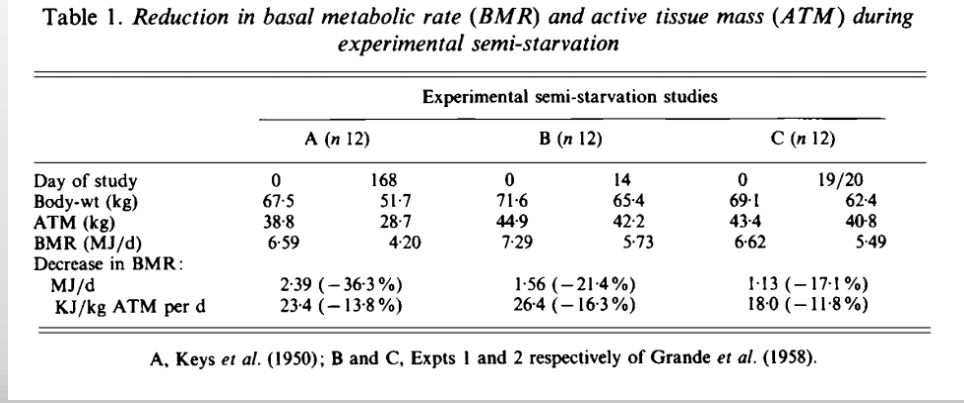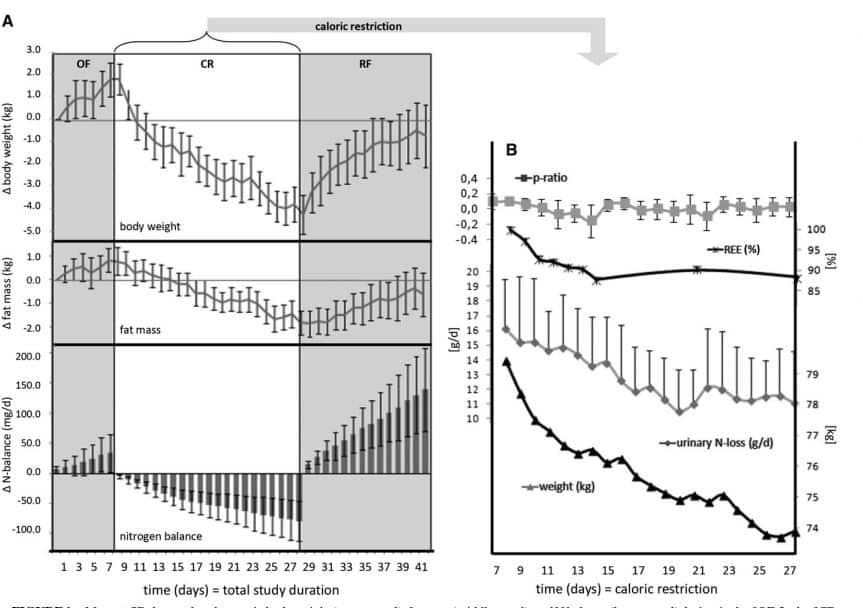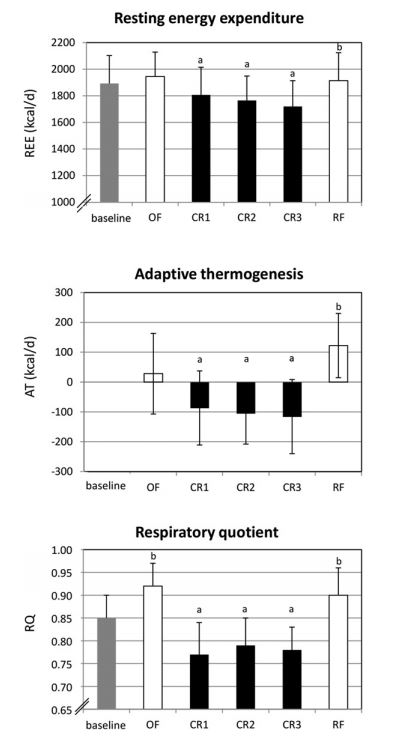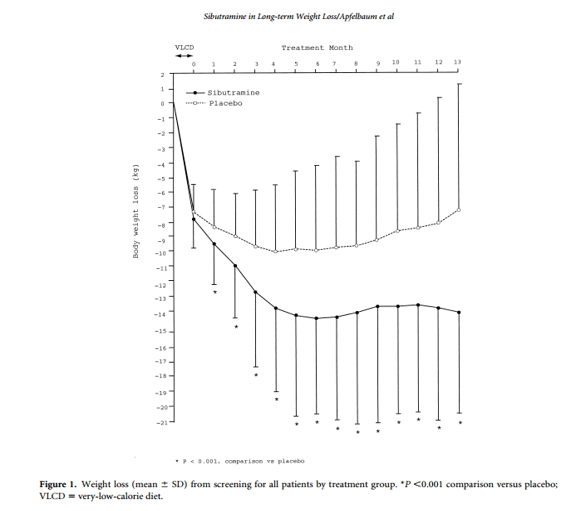TL;DR: Caloric restriction can reduce your “metabolism” but it comes back when you start eating more food and add more lean body mass. While a history of dieting may not be ideal for weight loss it doesn’t doom you. You just should probably focus more on building lean mass than burning calories during exercise.
Dieting and Metabolism
While many might think starvation is an issue of centuries and millennia past, even today there are pockets of civilization where starvation claims lives on a daily basis. Additionally, for many people attempting to lose weight, “starvation” type diets are implemented.
Starvation has been a real threat to human existence over for 99.9% of our tenure here on earth. Millennia of selective pressure have forced human biology to be shaped in the crucible of starvation. As such and our bodies have mechanisms that respond both physiologically and psychologically to starvation.
As we are hard-wired to induce a survival response to starvation or prolonged periods of severe calorie restriction it is likely that very low calorie diets/extreme dieting may not be the most effective tool for a long term view on weight loss.
However, the idea of having a forever ruined metabolism from “hardcore dieting” is probably also pretty inaccurate and you are not doomed to failure if that is your history. The hyperbole on this is well, hyperbole. You haven’t ruined yourself for life.
Thus I want to explore the physiology and psychology of crash diets, fasting, and very low-calorie approaches to weight loss in a series of articles. This one shall be the first of likely many. The thoughts contained in this article are a beginning of a comprehensive series. This article should serve as a great way for you to see how I as a scientist explore a topic, engage with data, generate questions, and often change my thinking as my knowledge grows and evolves.
There will be many unanswered questions, those are left on purpose, as tools to spur your own thinking in the coming weeks. Hopefully they also engage you as readers and prompt questions and comments that will help me work through a lot of the data and hard questions.
Starvation Diets in Research: Historical Context
When one thinks about research surrounding human starvation they often begin with the work of Ancel Keys. In the 1940’s Ancel Keys proposed a bold human experiment: to subject volunteers to semistarvation and then reefed them. The study, conducted on young healthy men, included a standardization protocol of 3 months where the mend received diets consisting of ~3200 kcal per day.
This was then followed by a 6 month semistarvation diet of roughly 1600 kcal per day. In addition to the diet, the participants were assigned varying jobs and expected to walk about 22 miles a week (~3/day). Some of the most physiologically notable findings from this paper (as related to this post) can be gleaned from this single table.

What we can see from the 24 week semistarvation study* is that the diets induced substantial weight loss and loss in active tissue mass. We also see reduced basal metabolic rate by about 36%. Now importantly, it appears that the active tissue mass itself had a lower metabolic rate, indicating it became either less active or more efficient. Now the study B in the above table was also a semi-starvation study in which participants only underwent starvation for 14 days. Notice the similar changes in basal metabolic rate that occur concurrently with the weight loss.
More Recent Very Low Calorie Diet Studies
Study 1
A recent “revisitation” of the experimental design used in the Minnesota Starvation study brought forth some really data (highlights below).


In addition to the changes in body weight, body fat, nitrogen balance, and changes in adaptive thermogenesis (AT), there were also some changes in hormones (i.e. thyroid and leptin), however there were no associations between those and the AT, suggesting they contribute only minutely to the changes in AT.
Now it is also important to note the work the authors did attempting to figure out what does acount for the change in AT and the magnitude of the effect they had on AT. After the changes in the composition of FFM (and thus massdependent effects) were accounted for, only 72 kcal/d can be considered “true” AT. That is fairly small. To quote the paper directly, “The calculation of resting energy expenditure (REE) according to the observed decreases in function-related changes in the specific metabolic rates of the heart (decrease in heart rate: 213%; 2384 kcal/kg) and kidneys (decrease in kidney function: 239%; 2269 kcal/kg) together with the apparent increases in liver-specific metabolic rates (206 kcal/kg as a result of increased gluconeogenesis as calculated from urinary urea excretion) add up to 40 kcal/d, which leaves 32 kcal/d or 44% of “true” AT unexplained.
Study 2
In a small study of 7 obese women, RMR was measured before and after massive weight loss using a protein sparing modified very low calorie diet. These women, while obese, were still relatively healthy and consumed a diet of roughly 300 kcal per day in which they consumed 45 grams of protein for between 10 weeks to 23 weeks, depending on the subject. Over the course of the intervention, the mean weight loss was about 28 kg (~62 pounds) with approximately 80% coming from fat and 20% coming from fat free mass.** During the diet, the RMR decreased 22% in these individuals, with loss of the fat-free mass accounting for 80% of the reducing in RMR (1). Additionally, it took approximately 8 weeks following the cessation of the severe restriction for the RMR to begin to recover.
However, 8 weeks after the diet, most individuals still saw substantially depressed RMR. This also jives with the idea that lean mass is responsible for a large portion of your RMR, these individuals likely didn’t rebuild the lean mass lost. Additionally, note the large individual variation in the changes in RMR during the calorie restriction and the refeeding period, there are quite large differences between individuals.
Study 3
In another study of 12 obese women, 4 weeks of a 1,000 kcal per day diet reduced RMR ~20%. Additionally, these women saw initial changes in thyroid (decreased T3 and increased rT3) during the first week, although these changes returned to normal the following week.
What can we conclude from these studies? Well it looks like your “metabolism” does indeed slow down quite substantially during periods of caloric restriction/starvation and that much of that adaptation is due to changes in lean mass and possible some minor changes in hormones. This indicates that lean mass is really the primary dictator in changes in energy expenditure during periods of starvation and refeeding. Pragmatically, this means lean mass should be prioritized in a substantial amount of people
Can You Jack up your RMR by Going HAM on all the food?
Now the question is if massive dieting can reduce your RMR can you increase your RMR by increasing the amount of food you eat? It appears that you can, as long as it comes with a concurrent increase in skeletal muscle mass (2). Essentially, you have to over eat and put in the work to build new tissue. Sorry, but for the vast majority of people you can’t just simply turn up your own thermostat by putting more gasoline on the fire. So someone coming from a starvation approach to dieting and attempting to “reverse” ought to focus on using the calories to build more muscle tissue. Perhaps that is why most people reversing out after competitions couple it with pretty hard training.
Let’s summarize what we see from these studies.
It appears that your metabolism is highly plastic and while severe, restrict dieting can cause your RMR to tank, you can bring it back up by increasing your calorie content. You are not doomed to an eternity of eating 1,000 calories. However, as with most things, it appears the climb back up is a bit slower.
A Glimpse into the Weight Loss Literature
Weight loss is also something explored in the psychology literature. Rapid weight loss is often “demonized” in popular culture but when you look at the actual studies something much more interesting and nuanced appears.
I found some data from a very interesting from the International Journal of Obesity back in 1989 (I was a year old). This study looked at the effect of 1-2 months of low-calorie diets and behavior modification on weight loss over a 2 year period. Here is my synopsis of their findings. They were able to show that 1-2 months of a very low calorie diet (420 kcal) was quite effective at inducing initial weight loss, almost 3 times as effective as the behavior modification. However, at the 2 year follow-up the very low calorie diet group had gained back more than half of their weight loss and their body weigh was higher than the behavior modification. Importantly, the trajectory of the two diets were substantially difference at follow up with the very low calorie group trending back to baseline while the behavior modification group was slowly, but surely, trending downward.

What this indicates is something we see a lot in practice. Rapid initial weight loss by very low calorie diets can be sustained when coupled with changes in behavior, however often times the behaviors aren’t really addressed and the skills aren’t developed or focused on during the “rapid weightloss”.

The rapid loss and eventual regain is not a one-time phenomena, it repeats itself over and over. The placebo groups in the sibutramine ( pharmaceutical agent that acts in the brain to enhance satiety and reduce hunger) studies are a perfect example. To spare the details, there were two trials looking at the effect of sibutramine on the maintenance of weight loss after a very low calorie diet (~480 kcal and ~220-800 kcal). In both studies the placebo group showed dramatic initial weight loss but the weight began to climb back up (3,4). I think this also indicates the same thing seen above wherein behaviors and habits make a substantial impact on sustained weight loss.
The Wrap Up
So let’s summarize what we see from these studies.
Let me reiterate from above. Well it looks like your “metabolism” does indeed slow down quite substantially during periods of caloric restriction/starvation and that much of that adaptation is due to changes in lean mass and possible some minor changes in hormones. This indicates that lean mass is really the primary dictator in changes in energy expenditure during periods of starvation and refeeding.
Pragmatically, this means lean mass should be prioritized in a substantial amount of people.
One key point to all this is that the research suggests you are not “doomed” to a forever lower metabolism based on a history of dieting, you just need to do some food work and some gym work to restore it to normal.
Additionally, it looks like traditional very low calorie “diet” schemes are designed to induce initial weight-loss and they often result in the eventual rebound unless there is some sort of intervention. These interventions can take a lot of different forms. Also, a lot of data suggests that very low calorie approaches to dieting become ineffective past a certain calorie threshold (this remains to be completely elucidated but probably anything less than 1,000-850 kcal/day is equivalent to banging your head against a wall).
This post leaves several questions unanswered. Just to name a few: 1) What are the psychological and behavioral consequences of very-low-calorie diets? 2) Are there optimal ranges of calorie deficits? 3) Do macronutrients effect weight loss in very-low-calorie paradigms?
*There are disparate reports of the diet with means ranging from 1,600-1,800 kcal/day
** This ratio is not what is typically seen in non-resistance training populations under severe caloric restriction. There is typically a ratio closer to 50:50 of fat:lean mass lost (this ranges depending on the population).
